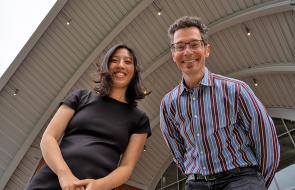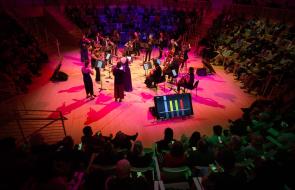 New Life for Gatsby: Harbison’s Roaring ‘20s Opera
New Life for Gatsby: Harbison’s Roaring ‘20s Opera
Has Its European Premiere in December
MIT Institute Professor John Harbison’s opera The Great Gatsby will have its first European performance at Dresden Semperoper this month. Commissioned by the Metropolitan Opera in celebration of renowned conductor James Levine’s 25th anniversary as Music Director, the work premiered at the Met in the 1999-2000 season and has since been presented by Lyric Opera of Chicago, reprised by the Met, presented in a reduced-orchestra version by Opera Parallele both in San Francisco and at the Aspen Music Festival, and in Boston and Tanglewood concert performances.
This first European production of The Great Gatsby will take place at Semperoper Dresden from December 6 through 21. It will be presented in English, with German subtitles. According to Semperoper, “The opera blends modern classical music with jazz and swing to paint a thrilling portrait of a debauched and decadent society, where double standards clash with idealism. European audiences can now enjoy this work for the first time.”
Wayne Marshall, renowned interpreter of the works of George Gershwin, Leonard Bernstein, Duke Ellington and other twentieth-century American composers, serves as music director. Keith Warner is stage director, with dramaturgy by Stefan Ulrich, and set design by the late Johan Engels, whose stunning and evocative work was seen in the New York and Chicago productions of The Passenger.
In making a new production of The Great Gatsby, Director Keith Warner does not adopt an “update” strategy, often seen in recent European productions. Instead he goes directly to the period, the American mid-twenties, making its excesses, its excitements, and its cloak of impending doom the essential color of the opera. Making full use of the radical, out-size, sculptural designs of Engels (who completed them just before his untimely death in spring of 2015), Warner sees the hectic party life, the fast cars, and music of the times as isolating and endangering the principal characters, many of whom have been scarred by their recent experiences in World War 1.
Europeans, very conversant with the Fitzgerald novel, tend to emphasize the role of class more than American readers. Warner uses a number of theatrical devices to starkly outline the attitudes and surroundings of the Wilsons, the working-class couple so crucial to conflicts within the story. The racist and elitist rants of Tom Buchanan, perhaps more comfortably folded into his familiar character by American fans of the book, emerge in stark outline in Warner’s conception.
Semperoper Dresden
www.semperoper.de
Peter Lodahl, tenor (Jay Gatsby)
www.peterlodahl.com
Maria Bengtsson, soprano (Daisy Buchanan)
www.mariabengtsson.com
Complete cast and production personnel
https://www.semperoper.de/en/whats-on/schedule/stid/Gatsby/60545.html
Video Clips: Staging Gatsby at Semperoper
https://www.semperoper.de/en/media-library/stid/Gatsby
Harbison photo by Julian Bullitt




